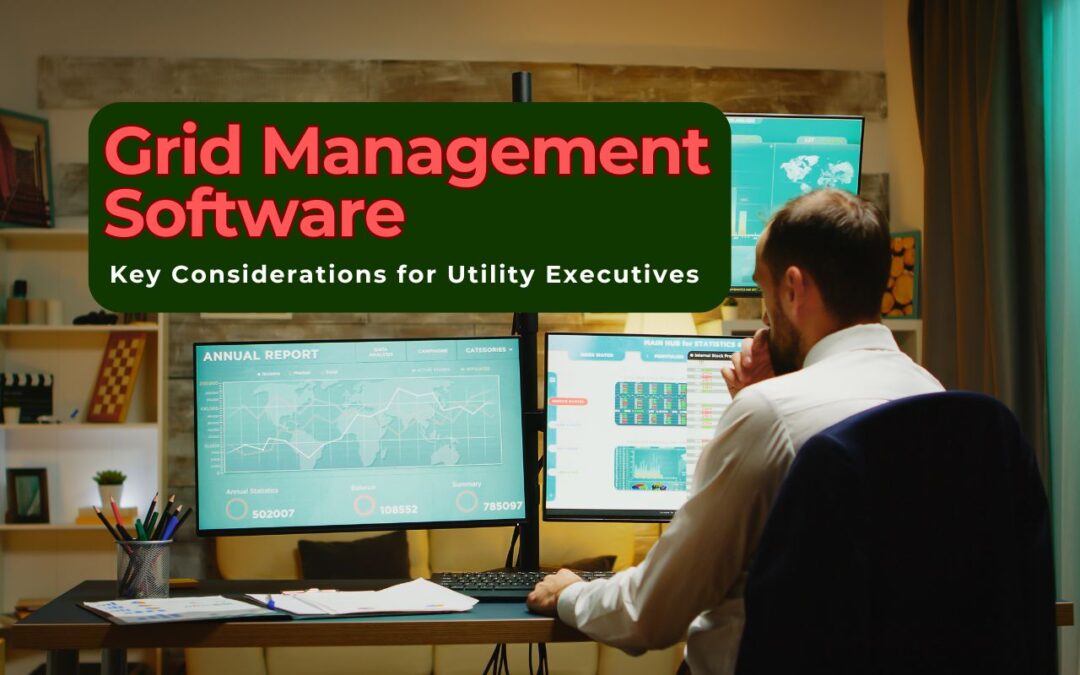In today’s rapidly evolving energy landscape, grid management software has emerged as a cornerstone of smart utility operations. As the global push toward renewable energy, grid decentralization, and digital transformation intensifies, utility executives face mounting pressure to modernize their grid infrastructure. Among the many strategies available, investing in grid management software stands out as one of the most impactful—and potentially one of the most complex.
This blog delves into the key considerations utility executives must weigh before investing in grid management software. From assessing infrastructure compatibility to aligning with future regulatory shifts, we’ll explore the most pressing aspects of this strategic decision and provide the insights needed to ensure a return on investment that benefits both utilities and their customers.
1. Understanding the Strategic Importance of Grid Management Software
Grid management software is not just a tool—it’s a transformative framework that enables real-time monitoring, automation, and optimization of grid operations. It allows utilities to:
- Improve reliability and reduce outages
- Integrate renewable energy sources more efficiently
- Enable demand response and distributed energy resources
- Enhance visibility into grid performance
As the grid becomes more dynamic and decentralized, these capabilities are critical. Without the right digital infrastructure, utilities risk falling behind both technologically and financially.
According to industry reports, over 75% of utilities globally are planning to increase investments in digital grid technologies over the next five years, with grid management software being a central component. This is being driven not just by operational benefits but also by regulatory and consumer expectations.
2. Evaluating Your Existing Infrastructure
Before making a decision, utility executives must conduct a comprehensive assessment of their current grid infrastructure. Many legacy systems are not designed to handle the complexity of modern energy flows, such as bidirectional power from prosumers or the integration of microgrids.
Key questions to ask:
- Is your current infrastructure digitally enabled?
- Are your sensors and data-gathering tools robust enough to feed real-time data into a management system?
- Can your control centers and teams handle the increased flow of data?
- Do you have communication protocols in place for remote and distributed assets?
Without addressing these questions, software investments may lead to limited gains or even operational complications. Grid management software must sit on a foundation of reliable hardware, connectivity, and trained personnel.
3. Data Integration and Interoperability
One of the biggest challenges in adopting grid management software lies in data integration. Utilities often operate with a patchwork of systems—from legacy SCADA controls to new smart meters and distributed generation dashboards. This data, unless standardized, can be difficult to use effectively.
Executives need to consider:
- Can the new software integrate seamlessly with existing systems?
- Will it allow cross-functional communication between departments like operations, billing, customer service, and regulatory affairs?
- Is the platform designed to evolve with the grid’s increasing data complexity?
Interoperability isn’t a luxury—it’s a necessity. Without it, the software may become siloed, hindering the very efficiency it is meant to achieve.
4. Cybersecurity and Risk Management
With the digitization of grid infrastructure comes a new frontier of risk: cyber threats. From ransomware to state-sponsored attacks, utility grids are increasingly targeted because of their critical role in national security and day-to-day life.
According to recent cybersecurity reports, the energy sector saw a 25% increase in cyber incidents year-over-year, with grid control systems being among the most targeted.
Key considerations for executives:
- Does the software include strong cybersecurity features?
- Can it detect anomalies in real time and trigger automated defense responses?
- Is it compliant with existing and upcoming cybersecurity regulations?
- How often is it updated to patch vulnerabilities?
Cybersecurity cannot be an afterthought. It must be embedded into every layer of the grid management software stack.
5. Scalability and Future-Proofing
Investing in grid management software is not just about solving today’s problems—it’s about anticipating tomorrow’s. With the rise of electric vehicles, community solar, peer-to-peer trading, and decentralized storage systems, the demands on the grid will only grow more complex.
Executives should look for:
- Scalable solutions that can grow alongside energy demands
- Modular architecture that allows adding new features without system overhauls
- Adaptability to evolving regulatory and technological standards
- Support for AI and machine learning for future predictive and autonomous grid operations
Failing to plan for growth means risking expensive replacements or retrofits in just a few years.
6. Training and Workforce Transformation
Software alone doesn’t run a utility. People do.
Utility executives must consider the human element of this transition. Even the most advanced system will falter if employees are untrained or resistant to change. Therefore, the workforce strategy should be a major component of the software investment plan.
This involves:
- Ongoing training programs for operational teams
- Cross-departmental collaboration on system use
- Change management strategies to ease the transition
- Hiring data analysts and cybersecurity specialists to interpret and safeguard grid data
A tech-savvy, agile workforce is essential for getting the most from your grid management software.
7. Total Cost of Ownership (TCO)
The upfront cost of grid management software can be substantial, but it’s only part of the picture. Utility executives must consider the total cost of ownership over a 10- to 20-year lifecycle.
Key TCO factors:
- Licensing or subscription fees
- Infrastructure upgrades needed for implementation
- Training and personnel costs
- Downtime or transition costs during deployment
- Long-term maintenance, support, and updates
Executives should ensure that projected efficiency gains, cost savings, and reliability improvements justify the full cost of implementation. Many successful utilities have reported operational savings and ROI payback within 3–5 years post-deployment.
8. Regulatory Compliance and Government Incentives
Regulatory frameworks are evolving quickly to encourage utilities to become smarter and cleaner. Grid management software is often a requirement—or at least a strong advantage—for compliance with emission targets, outage reduction mandates, or performance-based rate schemes.
In some regions, governments and regulators even provide financial incentives or grants for digital transformation initiatives in the energy sector.
Executives should:
- Stay updated on local and national regulations affecting grid modernization
- Align software capabilities with compliance reporting needs
- Explore funding programs, tax credits, and subsidies that can offset costs
9. Customer Impact and Engagement
Today’s utility customers expect more—more transparency, more control, more sustainability. Grid management software can empower utilities to meet these expectations by enabling features such as:
- Real-time outage updates
- Usage tracking and analytics for customers
- Integration with home energy management systems
- More accurate and transparent billing systems
Improved customer engagement not only enhances satisfaction but also supports smoother implementation of demand-side strategies, such as time-of-use pricing and energy efficiency programs.
10. Sustainability Goals and Carbon Reduction
Many utilities are now held accountable not just by regulators but by the public to contribute meaningfully to climate action. Grid management software plays a pivotal role in enabling sustainable practices by:
- Supporting the integration of renewable energy
- Managing storage and load balancing
- Facilitating virtual power plants and grid-edge technologies
- Enabling emissions tracking and carbon reporting
Utility executives must align software investments with their long-term environmental commitments, ensuring the tools they choose are equipped to help meet sustainability targets.
Final Thoughts: A Strategic, Not Just Technological, Investment
Investing in grid management software is more than a technical upgrade—it’s a strategic transformation that reshapes how utilities operate, serve their customers, and contribute to the broader energy transition. The stakes are high, but so is the potential payoff.
Utility executives must approach this decision holistically. That means considering infrastructure readiness, workforce transformation, regulatory alignment, cybersecurity resilience, and long-term scalability—all through the lens of operational efficiency and customer benefit.
The future of energy is digital, decentralized, and data-driven. Grid management software is not just a piece of the puzzle—it’s the operating system of tomorrow’s utility.













